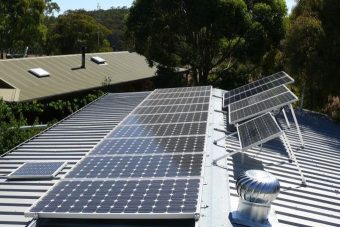
Residential solar panels are the Oklahoma energy sector’s version of Bigfoot: slowly gaining a larger following among urban dwellers but still elusive.
According to data from the Solar Energy Industries Association, a national solar energy advocacy organization, residential solar photovoltaic system installations were up 20 percent in 2016 from the previous year.
Closer to home, however, the numbers are smaller. AEP-PSO spokesman Ed Bettinger said about 150 residential and small-business customers participate in a net metering arrangement with the energy company, with most in the Tulsa metro.
Self-generating AEP-PSO customers have a special meter installed that measures both the amount of kilowatt hours generated by their solar panels that makes it back to the meter, as well as the amount of PSO-provided energy used at that particular address. Consumers can offset the amount of PSO-provided energy received but do not get compensation if their panels produce more energy than they use in any given month.
Statewide, SEIA estimates put the number of residential photovoltaic systems at less than 400 homes as of late 2016.
Part of the increased national interest in solar energy is due to a federal tax credit that allows both residential and commercial solar consumers to deduct 30 percent of the system installation costs off of their federal income taxes. Originally established as part of the Energy Policy Act of 2005, the investment tax credit was renewed in December 2015 through December 2021 as part of an effort to further encourage the growth of the solar industry.
Under the terms of the renewal, the tax credit drops to 26 percent in 2020 and down to 22 percent in 2021. Starting in 2022 and moving forward, only commercial users will be able to claim a 10 percent federal tax deduction.
Solar energy is popular in California, but last month city officials in South Miami, Florida, became the first city outside California to require new residential construction to be equipped with solar panels.
Oklahoma averages more than five hours of peak solar energy generating capacity per day and ranks among the top 10 states for solar energy potential.
However, less than 1 percent of the state’s electricity is generated by solar power. Solar panels across the state are generating an estimated 2.9 megawatts of energy, thus ranking Oklahoma 47th nationally for solar use.
Part of that stems from economics. Although federal enticements are available for residential consumers, they are few and far locally. Oklahoma offers a $0.0050 per kilowatt hour tax credit for solar power generated by zero-emission facilities, but it does not have any credits or rebates available to help lower the cost of installing solar panels.
Additionally, Oklahoma is one of a handful of states that prohibits consumers — both residential and commercial — from leasing solar panels. Instead, the panels have to be purchased with cash or a loan.
Local residential solar growth is further stunted by the relatively low cost of local conventional electricity. According to the U.S. Department of Energy, customers with the state’s two largest electric companies, AEP-PSO and OG&E, paid an average of $0.0907 and $0.0997 per kilowatt hour respectively, more than 3 cents per kilowatt hour less than the national average for residential customers.
Montelle Clark is the energy policy director for the Oklahoma Sustainability Network, a nonprofit that works to promote the use of long-term cleaner options for the state’s environment and economy.
Although his organization deals more with commercial entities, he noted that OSN is starting to see more inquiries across the board about solar energy as a fiscally viable option.
“We’re definitely seeing more interest in solar energy,” he said. “Part of the challenge though is that with our electricity prices so low, the payback period for solar panels can easily last 10 to 15 years, depending on how much power you use.”
Source: tulsaworld.com



